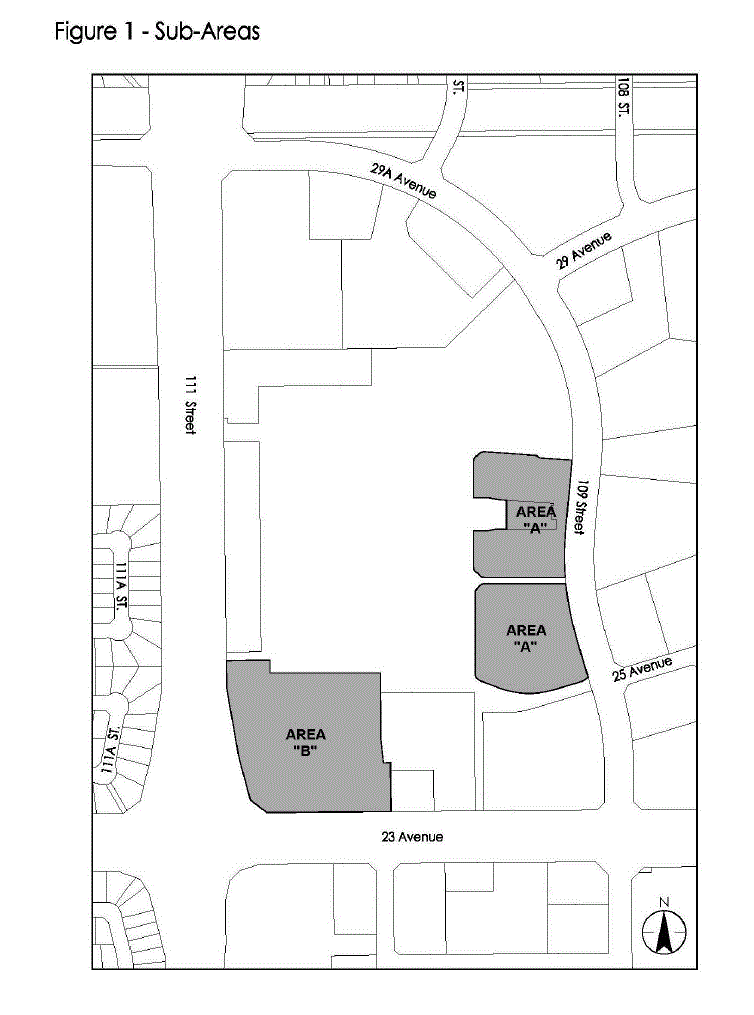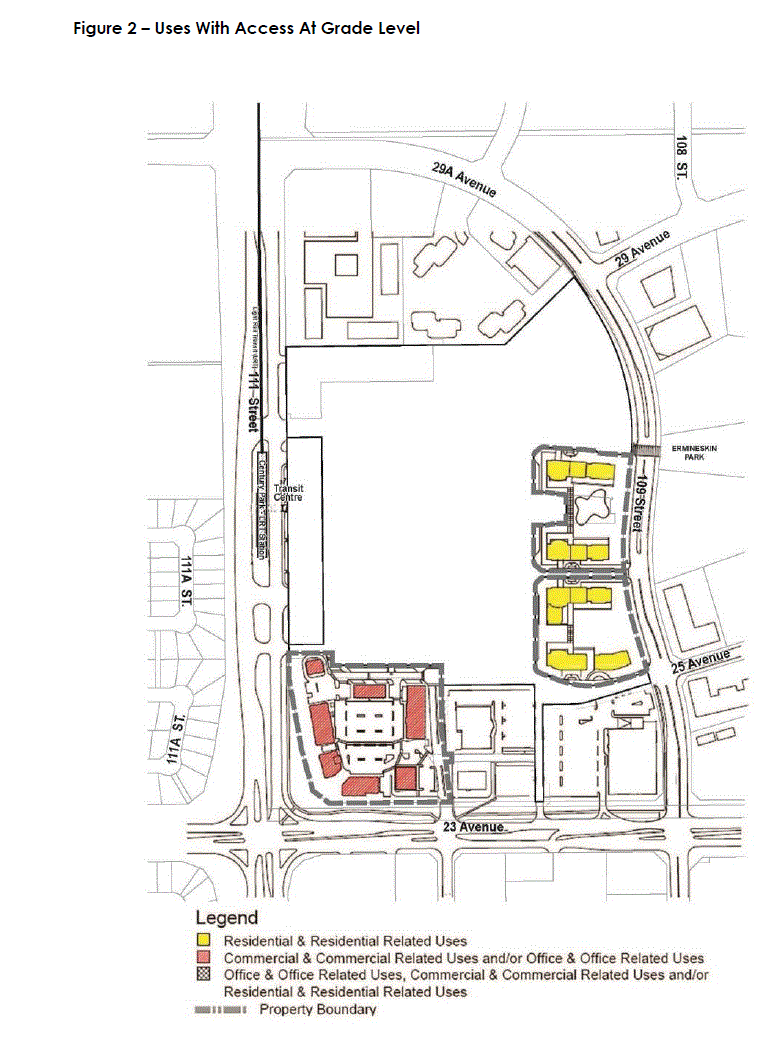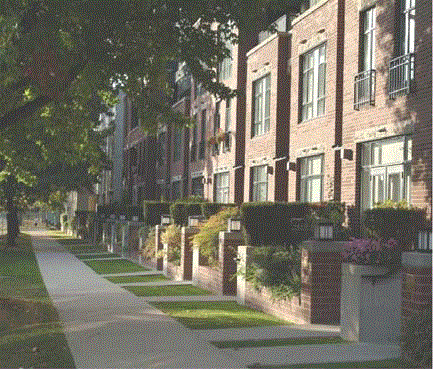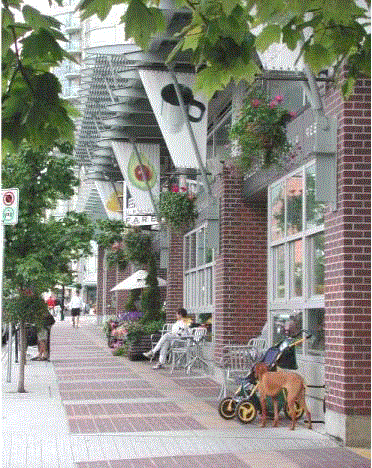Ermineskin - north of 23 Avenue and east of 111 Street
Bylaw 18057 (June 12, 2017)
To accommodate a commercial node and residential and commercial uses in a pedestrian-friendly environment that supports higher intensity Transit Oriented Development.
This Provision shall apply to Lot 12, Block 32, Plan 0523447, Lot 15A, Block 32, Plan 0929835, Condominium Plan 0923263, Units 1-409 and Condominium Plan 0940297, Units 1-500 within the Ermineskin neighbourhood, as shown on Schedule “A” of this Bylaw, adopting this Provision.
For general purposes the site area will consist of the following two areas, generally as shown in Figure 1:
Area A - row housing, low to mid rise apartment housing
Area B - street-oriented, low scale commercial buildings


Within Area A
Residential and Residential Related Uses
| a. | Apartment Housing |
| b. | Lodging Houses |
| c. | Child Care Services |
| d. | Extended Medical Treatment Services, limited to nursing homes |
| e. | Group Home |
| f. | Major Home Based Businesses |
| g. | Minor Home Based Businesses |
| h. | Residential Sales Centre |
| i. | Row Housing |
| j. | Stacked Row Housing |
| k. | Fascia On-premises Signs |
| l. | Projecting On-premises Signs |
| m. | Freestanding On-premises Signs, limited to project identification, building construction identification and real estate advertising signs of a limited duration |
| n. | Commercial and Commercial Related Uses |
| o. | Minor Impact Utility Services |
Within Area B
Commercial and Commercial Related Uses
| h. | Convenience Retail Stores |
| i. | Convenience Vehicle Rentals |
| j. | Creation and Production Establishments |
| k. | Drive-in Food Services |
| l. | General Retail Stores |
| m. | Government Services |
| n. | Health Services |
| o. | Household Repair Shops |
| p. | Indoor Participant Recreation Services |
| q. | Major and Minor Alcohol Sales |
| r. | Major and Minor Amusement Establishments, as an accessory use to a restaurant |
| s. | Minor Service Stations |
| t. | Personal Service Shops |
| u. | Private Clubs |
| v. | Private Education Services |
| w. | Professional, Financial and Office Support Services, including drive-through banks |
| x. | Public Education Services |
| y. | Rapid Drive Through Vehicle Services |
| z. | Residential Sales Centre |
| aa. | Restaurants |
| bb. | Specialty Food Services |
| cc. | Veterinary Services |
| dd. | Fascia On-premises Signs |
| ee. | Freestanding On-premises Signs |
| ff. | Projecting On-premises Signs |
In order to achieve the General Purpose of this Direct Control Provision, objectives and related design guidelines for the comprehensive development of the entire site are provided, in addition to development regulations. The Development Officer shall have regard for these objectives and design guidelines in order to ensure that development is compact, transit-oriented, of a high quality and integrates with surrounding neighbourhoods. The illustrative site plan is shown in Appendix I. Notwithstanding any of these objectives or design guidelines, the Development Regulations and the Appendices to this Provision shall take precedence.
DC2.952.4.1 Built Form
Objectives
| a. | Ensure that buildings and streetscapes are of a high quality design. |
| b. | Maximize solar penetration and avoid adverse microclimatic effects related to wind and shadowing on and off-site. |
| c. | Enliven the street by providing attractive streetscaping, active storefronts, and multiple doorways and windows. |
Guidelines
1. Building Height and Massing
| a. | The development should provide a transition in building height and massing in relation to the surrounding neighbourhoods. |
| b. | The taller buildings should be located near the centre of the site. |
| c. | Perceived height and massing should be minimized through such things as building setback variations at the upper levels, building orientation, roof treatment, and the choice of exterior materials and colours. |
2. Architectural Treatment of Buildings
| a. | All building façades should use compatible and harmonious exterior finishing materials. |
| b. | Building colors should provide visual interest. |
| c. | Mechanical equipment on the roof of any building should be concealed by incorporating it within the building roof, or by screening it in a way that is consistent with the character and finishing of the building. |
| d. | The design at rooftops visible from higher buildings should be carefully considered. Where feasible, rooftop gardens and patios should be provided to improve rooftop aesthetics and provide additional amenity space. |
| e. | Dwellings and other elements of the development should be sited and oriented to minimize their impact on other dwellings, considering such things as daylight, sunlight, ventilation, quiet, visual privacy and views. |
3. Building Relationship to the Street
| a. | To provide active and inviting streetscapes at ground level, buildings should feature doorways, porches and windows at ground level, as well as weather protection features such as awnings, canopies and arcades, as shown in Figure 4. |
| b. | Larger buildings with long street fronts should be designed with detail and articulation to create an attractive streetscape. |
| c. | Blank walls should be avoided by wrapping active retail or residential uses around above-grade parking structures to maintain an active and attractive streetscape. |
Figure 4 – Active Residential and Commercial Streetscapes

Active residential streetscape

Active commercial streetscape
DC2.952.4.2 Open Space
Objectives
| a. | Provide a safe and pleasing pedestrian environment that encourages walking. |
| b. | Create strong linkages within the site and connecting the site to City transit facilities, parks and other community amenities, and to surrounding communities. |
| c. | Provide a variety of open spaces and amenity areas. |
| d. | Ensure that many of the open spaces are accessible to people who do not live or work on the site. |
| e. | Ensure high quality open space design and landscaping. |
| f. | Minimize the ground surface area necessary for vehicular circulation, access and parking in order to increase the area devoted to open spaces and amenities. |
Guidelines
1. Pedestrian Circulation
| a. | Safe and attractive pedestrian linkages should be provided between various land uses within the site, surrounding neighbourhoods and transit facilities. |
| b. | The internal street system and pedestrian linkages should foster connectivity from various parts of the site and surrounding neighbourhoods to the transit terminal and LRT station. |
| c. | Pedestrian linkages should include both pedestrian mews access limited to emergency and service vehicles only and sidewalks included as part of the road right-of-ways |
| d. | Crime Prevention Through Environmental Design should be considered in the design of open spaces. Pedestrian spaces should be well lit at night and the gridded street pattern should avoid dead ends. |
2. Open Space
| a. | Development should include a variety of open spaces such as plazas, courtyards, pedestrian mews, greens and community gardens. |
| b. | Secure interior courtyards should serve as focal points for residents of a series of buildings. |
| c. | Open spaces should feature high quality landscape architecture intended to make them comfortable and enjoyable, including such features as trees, abundant street furniture, public art and water features. |
| d. | Site entrances and edges should receive special design attention to help ensure that the development presents an attractive and inviting face to surrounding areas. |
| e. | Internal streets should have tree-lined boulevards and should be lit at night with pedestrian-level lighting. |
| f. | Open spaces and parking areas should be designed to discourage criminal activity. |
| g. | Open spaces should be designed with consideration to winter city design principles. |
DC2.952.4.3 Roadways, Parking and Transit
Objectives
| a. | Provide a high degree of connectivity within the site and between it, transit facilities and surrounding areas. |
| b. | Provide a safe and pleasing pedestrian environment that encourages walking. |
| c. | Design the site to be conducive to movement by bicycle. |
| d. | Provide effective access and egress for automobiles and service and emergency response vehicles. |
| e. | Provide parking necessary for a transit-oriented development and an adjacent low-scale commercial area. |
Guidelines
1. Roadways and Parking
| a. | Traffic calming measures and pedestrian mews (access limited to service and emergency vehicles only) should be provided in the design to create a safe and attractive pedestrian environment. |
| b. | Streets should be designed to accommodate bicycles and bicycle parking should be abundant. |
| c. | The majority of parking should be provided in underground and concealed above grade parking structures providing for a more attractive pedestrian and living environment and reducing pedestrian / vehicle conflicts. |
| d. | Some short-term surface parking should be provided on internal streets and in Area B to serve commercial uses. |
| e. | Where possible, parking should be shared by users with staggered peak hours of demand. |
| f. | Service and emergency response vehicles should have clear and effective access to the buildings on the site. |
| g. | Parking, loading and passenger drop-off areas should be easily accessible and designed to minimize pedestrian-vehicle conflicts. |
| h. | Potential traffic impacts on adjacent roadways resulting from the development should be mitigated. |
DC2.952.4.4 Sustainability
Objectives
| a. | Integrate sustainable development principles in the planning and design of the development. |
| b. | Contribute to a socially sustainable community by providing housing for a range of household types, ages and physical abilities. |
| c. | Design the site to facilitate walking, cycling and transit use. |
Guidelines
| a. | The site should be a walkable mixed-use development with opportunities to live, work, shop and recreate. |
| b. | A mix of housing types should be provided on the site, including row houses; stacked row houses; and low and mid-rise apartments. |
| c. | Universally accessible design should be considered in the architecture of buildings and the design of open spaces. |
| d. | Where possible, buildings should be designed to include on-site alternative energy sources such as solar heat, solar electricity and geothermal energy. |
| e. | The incorporation of features such as daylighting, recycling, reuse of water, low-water landscaping and energy-efficient lighting and other devices should be considered in building and site designs to reduce the consumption of energy and materials. |
| f. | On-site infiltration of stormwater should be considered in the design of open spaces. |
| g. | To encourage alternatives to the automobile, the development should be walkable, conducive to bicycles and integrated with transit facilities. Locations for car-sharing vehicles should be planned for residential parking facilities. |
| a. | The Site development shall be in general accordance with the Illustrative Site Plan attached as Appendix I and buildings shall be located in general accordance with Appendix II. | ||||||||||||
| b. | The Development Officer, in consultation with the Planning Coordination and Urban Design Sections, may allow for variance in location of individual buildings provided that consideration has been given to the objectives and design guidelines of this Provision and to visual, shadowing, and other microclimatic impacts on adjacent residential development. | ||||||||||||
| c. | In the event that a variance is granted, the Development Officer shall specify the nature of the approved variance in the development permit approval. | ||||||||||||
| d. | The maximum Floor Area Ratio for Area A shall be 0.5 and Area B shall be 1.2. | ||||||||||||
| e. | To add character and interest and to conceal mechanical equipment located at the top of a building, the use of two storey high space within a residential dwelling unit shall be permitted. Adding an additional floor to the massing to conceal mechanical equipment shall not be counted as a storey if it: occurs at the top of the building; occurs within a residential dwelling unit; the building does not exceed the maximum height limit; the area of the upper level within the residential dwelling unit is smaller than the floor below; and the upper level within the residential dwelling unit is not serviced by an elevator. | ||||||||||||
| f. | The maximum Height for Area A shall be 29 m. The maximum Height for Area B shall be 19 m. | ||||||||||||
| g. | Notwithstanding 5(e), the maximum Height for Stacked Row Housing shall be 15 m. | ||||||||||||
| h. | A maximum of 400 Dwellings is permitted. | ||||||||||||
| i. | The finishing material for all development shall be of high quality, consisting of glass and glazed window wall systems, brick, stone, architectural concrete, pre-cast coloured concrete, stucco panels (to a maximum of 15% of the buildings’ exterior surface areas), or pre-finished metal. | ||||||||||||
| j. | Mechanical equipment on the roof of any building shall be concealed by incorporating it within the building roof, or by screening it in a way that is consistent with the character and finishing of the building. | ||||||||||||
| k. | Minimum building Setbacks from the edge of the Site and the edge of the internal road rights-of way shall be as shown in Appendix III. | ||||||||||||
| l. | As a condition of issuing a development permit for a Major Home Based Business the Development Officer may impose any condition that will help to ensure that the residential character of the development is maintained including, but not limited to the following:
|
||||||||||||
| m. | Active commercial frontages as shown in Appendix IV shall be developed with regard to Section 4.1 of this Direct Control Provision and according to the following regulations:
|
||||||||||||
| n. | Parking and circulation areas within and surrounding Area B shall be developed with regard to Section 4.3 of this Direct Control Provision and according to the following regulations:
|
||||||||||||
| o. | Active residential frontages as shown in Appendix IV shall be developed with regard to Section 4.1 of this Direct Control Provision and feature ground level units with individual external accesses and terraces or other landscaped open space, and common residential entrances. | ||||||||||||
| p. | Notwithstanding regulations 5(l) and 5(n) and Appendix IV, active commercial and residential frontages shall not be required where building lobby and parking entrances are located. | ||||||||||||
| q. | Open space shall be provided with regard to Section 4.2 of this Direct Control Provision and in general accordance with Appendix V. The minimum amount of publicly accessible open space shall be 27, 000 m2. | ||||||||||||
| r. | The landscape plan required through Section 55.3 of the Zoning Bylaw shall include the design of the adjacent internal streetscapes with regard to Sections 4.2 and 4.3 of this Direct Control Provision and to the satisfaction of the Development Officer. In addition to the planting requirements of Section 55.4 of the Zoning Bylaw, the developer shall provide, on each side of all internal roadways, a minimum of one street tree for every ten meters of internal roadway and pedestrian mews. | ||||||||||||
| s. | Barrier Free Design
|
||||||||||||
| t. | Apartment Housing and Group Homes intended to facilitate the provision of housing in which care is provided on site to residents on a permanent basis shall be developed in accordance with Section 94 of the Zoning Bylaw. | ||||||||||||
| u. | Pedestrian linkages shall be developed with regard to Sections 4.2 and 4.3 of this Direct Control Provision and generally in accordance with Appendix VI to this Provision. | ||||||||||||
| v. | Vehicular access and circulation shall be developed with regard to Section 4.3 of this Direct Control Provision and generally in accordance with Appendix VII to this Provision. | ||||||||||||
| w. | Vehicular Parking on the site shall be developed in accordance with Schedule 1 of Section 54.2 of the Edmonton Zoning Bylaw. | ||||||||||||
| x. | Notwithstanding 5(v), at such time as a Shared Use Parking Impact Assessment is submitted, the applicant for a development permit may apply for a reduction to the minimum number of parking spaces, to the satisfaction of the Development Officer, in consultation with Transportation Planning & Engineering. The applicant must demonstrate through a Shared Use Parking Impact Assessment that by virtue of the use, character, or location of the proposed development, and its relationship to public transit facilities and any other available parking facilities, the parking required for the proposed development may be less than any minimum set out in Schedule 1(A) of Section 54 of the Zoning Bylaw. | ||||||||||||
| y. | Bicycle Parking spaces shall be no less than 10% of the number of vehicular parking spaces required. | ||||||||||||
| z. | Public access easements shall be provided as a condition of subdivision for internal roadway areas and the central oval open space designated as publicly accessible open space. Easements shall make the private property owner(s) responsible for maintenance and liability. | ||||||||||||
| aa. | All vehicular loading and garbage collection for residential buildings shall be conducted within parking structures. | ||||||||||||
| bb. | Signs shall comply with the regulations found in Schedule 59E. | ||||||||||||
| cc. | Portable Signs shall be prohibited on this site. | ||||||||||||
| dd. | No construction noise shall be generated on the site before 10 a.m. on Sundays. |
